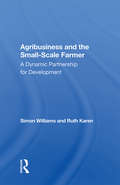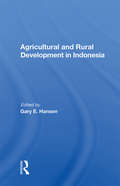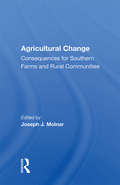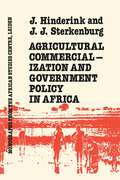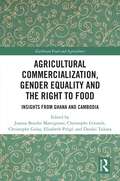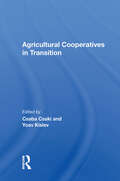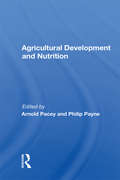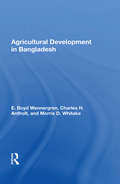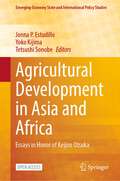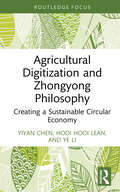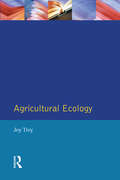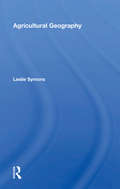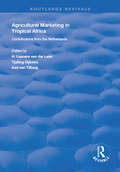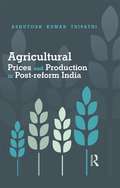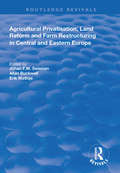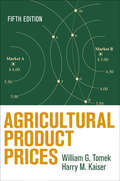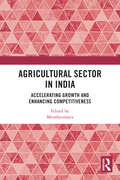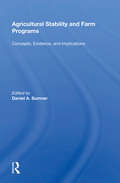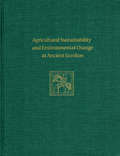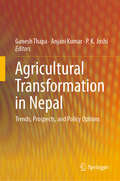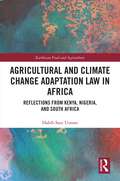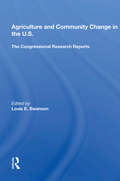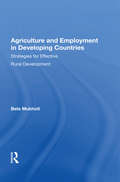- Table View
- List View
Agribusiness And The Small-scale Farmer: A Dynamic Partnership For Development
by Simon Williams Ruth KarenBased on case histories from nine Third World countries, this study examines the successful cooperation between private agribusiness firms and small farmers to increase agricultural production and income in developing countries. In such ventures, small farmers are organized around a core private company that buys their output and provides manageria
Agricultural And Rural Development In Indonesia
by Gary E HansenThis book provides a broad, interdisciplinary overview of the major facets of Indonesia's contemporary agricultural and rural development, while exploring the macro and micro factors that account for uneven development patterns. In assessing the rate and distribution of economic growth within the rural sector of the Indonesian archipelago, the auth
Agricultural Change: Consequences For Southern Farms And Rural Communities
by Joseph J. MolnarThis book examines the impact of the rise and fall of new commodities, production technologies, and shifting government policies on individuals and farm families in the rural South and the interrelationship between agricultural change and community change.
Agricultural Commercialization And Government Policy In Africa
by HinderinkFirst published in 1987. Routledge is an imprint of Taylor & Francis, an informa company.
Agricultural Commercialization And Government Policy In Africa
by J. Hinderink J.J. SterkenburgFirst published in 1987. The object of this book is to show the nature and the constraints of the commercialization of agriculture in one of the world's major problem areas, Sub-Saharan Africa. Agricultural commercialization started here centuries ago, albeit in small, pockets. It expanded sharply during the colonial period when the sub-continent became integrated into the world's economy. After independence the nature of this integration did not structurally change and the basic characteristics o agricultural commercialization remained unaltered. After an analysis of this process during the colonial period, the study focuses on post-colonial government policies and on spatial variation in the commercialization of Africa's agriculture. Differences in environmental and socio-economic conditions, production performance and government policy are dealt with on two geographical scales: in the fist at the level of macro-regions and individual countries, and the second, by means of case studies at the regional, village and project level. Thee field-work based studies each centre on a specific aspect of commercialization process in a wide variety of countries, viz Swaziland, Sudan, Botswana, Ivory Coast, Mali and Kenya. The final part of the book relates the subject of commercialization and rural development to Africa's present agricultural crisis.
Agricultural Commercialization, Gender Equality and the Right to Food: Insights from Ghana and Cambodia (Earthscan Food and Agriculture)
by Christophe Golay Elisabeth Prügl Joanna Bourke Martignoni Christophe Gironde Dzodzi TsikataThis volume explores agricultural commercialization from a gender equality and right to food perspective. Agricultural commercialization, involving not only the shift to selling crops and buying inputs but also the commodification of land and labour, has always been controversial. Strategies for commercialization have often reinforced and exacerbated inequalities, been blind to gender differences and given rise to violations of the human rights to food, land, work and social security. While there is a body of evidence to trace these developments globally, impacts vary considerably in local contexts. This book systematically considers these dynamics in two countries, Cambodia and Ghana. Profoundly different in terms of their history and location, they provide the basis for fruitful comparisons because they both transitioned to democracy in the early 1990s, made agricultural development a priority, and adopted orthodox policies of commercialization to develop the sector. Chapters illustrate how commercialization processes are gendered, highlighting distinctive gender, ethnic and class dynamics in rural Ghana and Cambodia and the different outcomes these generate. They also show the ways in which food cultures are changing and the often-problematic impact of these changes on the safety and quality of food. Specific policies and legal norms are examined, with chapters addressing the development and implementation of frameworks on the right to food and land administration. Overall, the volume brings into relief multiple dimensions shaping the outcomes of processes of commercialization, including gender orders, food cultures, policy translation, national and sub-national policies, corporate investments and programmes, and formal and informal legal norms. In doing so, it offers insight not only on our case countries, but also provides proposals to advance rights-based research on food security. This book will be of great interest to students and scholars of food security, agricultural development and economics, gender, human rights and sustainable development.
Agricultural Cooperatives In Transition
by Csaba Csaki Yoav KislevOriginally published in 1993, this is a study of agricultural co-operatives. The farming structure in transition countries has shifted from dominance of large corporate farms to family smallholdings. Smallholders everywhere experience difficulties with access to market services, including sale of products, purchase of inputs, and acquisition of machinery; they suffer from credit shortages and have limited access to information and advisory services. The barriers to market access prevent smallholders from fully exploiting their inherent productivity advantages. Best-practice world experience highlights farmers' service cooperatives, created by grassroots users, as the most effective way of improving the market access of small farmers. Service cooperatives also help smallholders overcome market failures, when private business entrepreneurs are unwilling to provide services in areas that they judge unprofitable or unfairly exploit users through monopolistic practices. These difficulties and market failures are prominent in transition countries and scholars accordingly expected rapid development of agricultural service cooperatives in response to smallholder needs. The present volume explores gaps between expectations and reality.
Agricultural Development And Nutrition
by Arnold Pacey Philip PayneThis book is an expose of the many food consumption-related problems which need to be considered alongside agricultural production issues in development. It examines factors that determine the degree to which people have access to food and can assimilate its nutrients.
Agricultural Development In Bangladesh: Prospects For The Future
by E. Boyd WennergrenThe performance of the agricultural sector and other related areas of the economy of Bangladesh are assessed in this book, which includes descriptions and analyses of Bangladesh’s natural and human resource bases; trends in agricultural input use and production of major crops; the agricultural marketing system; public sector interventions, organization, and financing; donor programs; and the agricultural research, extension, and educational systems. The authors identify positive factors contributing to sectoral growth and development as well as specific constraints to progress and conclude by offering an overall development strategy for achieving increased agricultural productivity, complete with specific policy and programming recommendations.
Agricultural Development in Asia and Africa: Essays in Honor of Keijiro Otsuka (Emerging-Economy State and International Policy Studies)
by Tetsushi Sonobe Jonna P. Estudillo Yoko KijimaThis Open Access book explores the multifaceted nature of agricultural and rural development in Asia and examines the extent to which the Asian experience is being replicated in contemporary Africa. This volume compiles the works of top scholars who provided analyses and evidences from household-level surveys collected for many years in several parts of Asia and Africa. The most important finding presented in this book is that African agricultural development has evolved following the pathways of Asian agricultural development. The common pathways are borrowed technology from abroad and adaptive research in rice farming; secured property rights on natural resources; adoption of ICTs; investments in human capital, including training; and launching of the high-value agriculture. In both continents, agricultural development started in the crop sector, which had a strong tendency to induce the dynamic development of other sectors in rural areas.
Agricultural Digitization and Zhongyong Philosophy: Creating a Sustainable Circular Economy (Routledge Focus on Environment and Sustainability)
by Ye Li Yiyan Chen Hooi Hooi LeanThis interdisciplinary book combines digital technology with Eastern philosophy to examine how the concept of Zhongyong in Confucianism can be used to coordinate digital technology with sustainable agriculture. Zhongyong comes from the connotation of moderate and sustainable in ancient Chinese culture. It is with this concept in mind that this book presents a novel collaboration between philosophy and computer technology to explain how Zhongyong can play an important part in realizing agricultural digitization within a circular economy in order to help solve the current food crisis. The book examines two popular, yet contradictory, digital technologies—blockchain and the green data center. It showcases how the use of traditional Chinese Zhongyong can promote the decentralization of blockchain and the centralization of the green data center and explains the advantages of using both technologies simultaneously. The book puts forward a digital circular agricultural framework that embeds both blockchain and the green data center through an actual case study. While this book specifically focuses on agriculture, it also provides readers with a new perspective for thinking further on how to break down the disciplinary barriers between the social sciences and natural sciences. This book will be of great interest to students and scholars of agriculture, digital technologies, circular economy, sustainable development, and Eastern philosophy.
Agricultural Ecology
by Joy TivyThis book analyses the nature of the relationships between crops, livestock and the bio-physical environment, and the extent to which man has managed and modified the products and environment to suit his/her own particular needs.
Agricultural Geography
by Leslie SymonsThis book provides a historical summary of agricultural development and representative ways in which agricultural production is undertaken in different social, economic and physical environments. It describes concepts and methodology for understanding any area or type of farming.
Agricultural Land Use: Structural Transformations, Environment Challenges, Planning and Policy (Earthscan Food and Agriculture)
by Jerzy BańskiThis book presents contemporary trends and challenges in agricultural land use, drawing on an array of global case studies.This volume examines agricultural land use through a three-pronged approach: structural transformations, environmental challenges, and planning and policy. Reflecting the global relevance of contemporary challenges to agricultural land use, the book presents a wide range of novel case studies from across the world, including Poland, Hungary, Denmark, Slovenia, Czechia, Tanzania, Uganda, South Africa, Algeria, Northeast Africa countries, China, India, Australia, New Zealand, USA, and Brazil. Each chapter focuses on a particular issue related to agricultural land use in that country or region, including land fragmentation, reduction of crop land, agricultural intensification, desertification of soils, climate change, biodiversity loss, traditional agricultural systems, urbanization and rural development, and planning challenges for agricultural land. Together the chapters present a global view of the challenges facing the agricultural industry and offer solutions for developing sustainable agricultural practices to ensure food security and environmental and biodiversity conservation.This book will be of great interest to students and scholars of food and agriculture, land use and land management, rural studies, and sustainable development.
Agricultural Marketing in Tropical Africa: Contributions of the Netherlands (Routledge Revivals)
by Aad Van Tilburg H. Laurens van der Laan Tjalling DijkstraFirst published in 1999, this volume explores how African agriculture has always had a strong appeal for the people of the Netherlands. This is due to (1) a long-established interest in tropical agriculture going back to the days when Indonesia was a Duth colony; (2) a broad-based desire to help the Third World; and (3) the view that Tropical Africa is highly dependent on agriculture. As practical expertise in Africa and systematic research on African agriculture grew, specialization became both possible and necessary. This volume reflects the specialization in marketing which has been welcomed by economists, geographers and scholars of agricultural marketing. In addition to a general introductory chapter, this book includes five contributions on staple food grains, two on export crops, two on cattle and one on horticulture. Nine of the chapters are country-specific, covering Benin, Burkina Faso, Cameroon, Cȏte d’Ivoire, Ghana, Kenya, Sierra Leone, Tanzania and Zambia.
Agricultural Prices and Production in Post-reform India: An Inquiry Into The Post-reform Period
by Ashutosh Kumar TripathiPost-reform India has seen a decline in agricultural growth as well as supply–demand imbalance and rising prices. This book presents a comprehensive analysis of domestic and international prices and trade since 1980–81, covering the past quarter of a century. Backed with rich data, it provides comparisons between the pre- and post-liberalisation policies and their effect on farm profitability, domestic prices and prices variability, and examines their possible role in determining the trajectory of agricultural growth since 1991. The book will appeal to students, scholars and researchers of agriculture studies, economics, finance, and development studies, as well as policy makers and agriculture experts.
Agricultural Privatization, Land Reform and Farm Restructuring in Central and Eastern Europe (Routledge Revivals)
by Johan F.M. Swinnen Allan Buckwell Erik MathijsFirst published in 1997 in the wake of the fall of the Soviet Union and its agricultural policies, these editors presented a series of ten related articles on the transition to post-communist, more privatised agricultural policies, each specialising in a specific region of Central and Eastern Europe. Resulting from a research network, this volume features a range of contributors, including those preparing PhDs, former governmental advisors and specialists in agricultural economics, food policy and statistics. The chapters cover Albania, Bulgaria, the Czech Republic, Eastern Germany, Hungary, Romania, Slovakia, Solvenia, and the Former Soviet Union, along with a comparative analysis. The contributors focus on three key issues of reform: the collection of detailed data, the collection of information on factors influencing the progress and completion of reform and explaining the results of privatisation and land reform, with a particular emphasis on the first two elements. This volume is well-suited to policy makers, analysists and researchers.
Agricultural Product Prices
by Harry M. Kaiser William G. TomekPublished continuously since 1972, Agricultural Product Prices has become the standard textbook and reference work for students in agricultural and applied economics, buyers and sellers of commodities, and policymakers, clearly explaining conceptual and empirical models applicable to agricultural product markets. The new fifth edition uses up-to-date information and models to explain the behavior of agricultural product prices. Topics include price differences over market levels (marketing margins), price differences over space (regionally and internationally) and by quality attributes, and price variability with the passage of time (seasonal and cyclical variations, trends, and random behavior). William G. Tomek and Harry M. Kaiser review and adapt microeconomic principles to the characteristics of agricultural commodity markets and then apply these principles to the various dimensions of price behavior. They also provide an in-depth discussion of prices established for futures contracts and their relationship to cash (spot) market prices; cover the influential roles of price discovery institutions, such as auctions and negotiated contracts, and government policies regulating trade and farms; and discuss the specification, use, and evaluation of empirical models of agricultural prices, placing emphasis on the challenges of doing high-quality, useful analyses and interpreting results.
Agricultural Sector in India: Accelerating Growth and Enhancing Competitiveness
by MruthyunjayaThis book presents a comprehensive overview of a range of concepts, methods, strategies and policies in agriculture and natural resource management, environmental economics, production economics and sustainable agricultural development. It explores effective analytical tools and science, innovations, and management solutions to enhance yields, manage the supply chain, strengthen institutional mechanisms, and service and support systems for farmers. It highlights the importance of enabling policies which can benefit farmers, resulting in cost-efficient and quality-improving farm practices, increased profits and income for farmers, and better management of natural resources. The essays in the book honour the academic, teaching, and research contributions of Professor R. Ramanna in the field of agricultural economics. They also address issues which are relevant to the growing research in sustainable agricultural development and natural resource management including the use of new concepts, tools, analyses, technologies, innovations, and policy strategies modelled in local contexts that can easily be scaled and applied to similar contexts elsewhere. This book will be of interest and use to students, researchers, practitioners,and policymakers working in varied fields of agricultural economics, sustainable development, public policy, rural sociology, political economy, economics of innovation, institutional economics, and industrial organisation.
Agricultural Stability And Farm Programs: Concepts, Evidence, And Implications
by Daniel A. SumnerThis book attempts to contribute to a fuller understanding of perennial issues underlying farm problems and agricultural policies in the United States thus contributing to better projections of policy effects, to better forecasts of policy changes, and perhaps to better policy for agriculture.
Agricultural Sustainability and Environmental Change at Ancient Gordion: Gordion Special Studies 8
by John M. MarstonThis book publishes the results of 220 botanical samples from the 1993-2002 Gordion excavations directed by Mary Voigt. Together with Naomi Miller's 2010 volume (Gordion Special Studies 5), this book completes the publication of botanical samples from Voigt's excavations. The book aims to reconstruct agricultural decision making using archaeological and paleoenvironmental data from Gordion to describe environmental and agricultural changes at the site.John M. Marston argues that different political and economic systems implemented over time at Gordion resulted in patterns of agricultural decision making that were well adapted to the social setting of farmers in each period, but that these practices had divergent environmental impacts, with some regimes sponsoring sustainable agricultural practices and others leading to significant environmental change. The implications of this book are twofold: Gordion will now be one of the best published agricultural datasets from the entire Near East and, thus, serve as a valuable comparable dataset for regional synthesis of agricultural and environmental change, and the methods the author developed to reconstruct agricultural change at Gordion serves as tools to engage questions about the relationship between social and environmental change at sites worldwide. Other books address similar themes but none in the Near East address these themes in diachronic perspective such as we have at Gordion.University Museum Monograph, 145
Agricultural Transformation in Nepal: Trends, Prospects, and Policy Options
by P. K. Joshi Ganesh Thapa Anjani KumarThis book addresses some key strategic questions related to agriculture in the context of major contemporary developments and emerging challenges in Nepal such as the changing role of agriculture with economic growth, structural transformation in reducing poverty, improving nutritional outcomes, and addressing the challenges of climate change. The book also suggests policy measures to improve the delivery of critical inputs and services and ensure the participation of marginal and smallholders in high-value chains. Further, it discusses how the new federal system and governance structure will affect the delivery of agricultural technology and services. The book is divided into five parts. Part I discusses macro-issues in the agriculture sector, while Part II focuses on agricultural productivity growth and its main drivers. The third part explores diversification in the agricultural and non-agricultural sectors by farmers and other rural people for livelihood improvement, while the fourth part deals with agricultural trade and marketing issues, highlighting policy implications and recommendations in the areas of immediate focus and further research. Lastly, Part V addresses institutions and governance issues, which are vital for agricultural development. In the final chapter, the editors summarize and synthesize the book’s main findings and develop a policy agenda for addressing the many challenges faced by the agriculture sector in Nepal, so as to make it more productive, competitive, sustainable, and inclusive. The book offers a rich source of analytical information on various aspects of agricultural development in Nepal and will be of immense value to policymakers, development partners, civil society, students, and those interested in the economic and agricultural development of not only Nepal, but also other developing countries.
Agricultural and Climate Change Adaptation Law in Africa: Reflections from Kenya, Nigeria, and South Africa (Earthscan Food and Agriculture)
by Habib Sani UsmanThis book presents an analysis of climate change and agricultural laws in Kenya, Nigeria, and South Africa in order to determine whether they adequately addressed the concept of agricultural adaptation.Agriculture is one of the sectors of the economy that is contributing to climate change, and at the same time the sector is heavily impacted by climate change. Therefore agricultural adaptation is required. Focusing on three countries, this book provides a novel, comparative examination of how and to what extent the law promotes agriculture-focused adaptation in these countries. The role of the law in addressing issues such as water management strategies, soil conservation methods, and crop production methods is discussed. This book identifies gaps in the regulatory frameworks for agricultural adaptation and highlights the lack of adaptive capacity of African agriculture due to weak or non-existing legal frameworks. It discusses ways to remedy these gaps through specific on-farm adaptation strategies, legislative amendments to consolidate all relevant national climate change-related policies and laws with agricultural policies and laws that have relevant provisions on adaptation as medium-term solutions, and the development of a specific framework law for agriculture-focused adaptation, incorporating essential agricultural adaptation strategies, could perhaps be enacted as long-term solutions to the regulatory gaps.This book will be of great interest to students and scholars of law, climate change, food and agriculture, sustainable development, and African studies.
Agriculture And Community Change In The U.s.: The Congressional Research Reports
by Louis E. SwansonThis book contains the Office of Technology Assessment commissioned papers analyzing the Northeast, South, Midwest, the Great Plains and the West of the U.S. The papers indicate that the relationship between the structure of agriculture and characteristics of rural communities vary in the U.S. .
Agriculture And Employment In Developing Countries: Strategies For Effective Rural Development
by Bela B MukhotiHigh rates of growth in agricultural production need not be incompatible with increased employment, income, and the satisfaction of basic needs in the lower-income developing countries. Emphasizing this theme, the author presents three alternative agricultural development strategies and suggests guidelines for identifying appropriate policies and p
